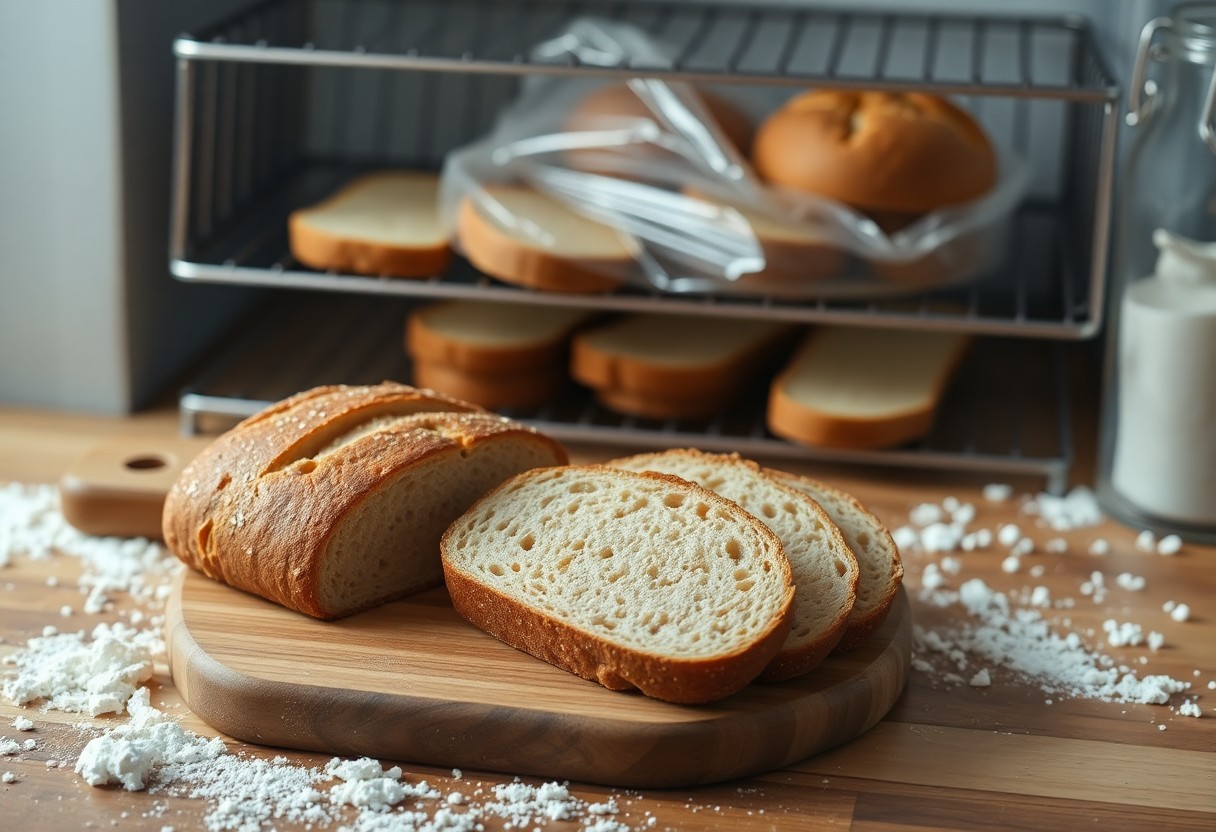As you explore into the world of sourdough baking, you may wonder what to do with your freshly baked loaves when you can’t consume them immediately. You’ve invested time and love into crafting your sourdough, and now you want to preserve its freshness. Your question is answered here, as we explore the possibilities of freezing your delicious homemade sourdough bread, allowing you to enjoy it at your convenience, whenever you desire a slice of that warm, comforting goodness.

The Basics of Sourdough Bread
A wonderful journey into the world of sourdough bread begins with understanding its unique characteristics. You’ll discover that sourdough bread is made using a natural starter culture, which gives it a distinct flavor and texture.
What is Sourdough Bread
One of the most interesting aspects of sourdough bread is its slow fermentation process, which you’ll find develops a more complex flavor profile. You’ll love how the tangy taste and chewy texture set it apart from other types of bread.
Importance of Freezing Sourdough
With your newfound appreciation for sourdough bread, you’ll want to know how to preserve it. You’ll be pleased to know that freezing is an excellent way to maintain its freshness and flavor, allowing you to enjoy your favorite loaf whenever you like.
In fact, freezing sourdough bread is a great way to extend its shelf life, and you’ll find that it’s quite simple to do. You can freeze the dough before baking or freeze the baked loaf, and either way, you’ll be able to savor the delicious taste and aroma of your freshly baked sourdough bread at your convenience, which is perfect for your busy schedule.
Freezing Sourdough Bread
Now that you’re wondering about preserving your sourdough bread, you can find the answer to Can You Freeze Sourdough Bread? and discover the joys of having fresh-tasting bread anytime.
Methods of Freezing
Methods for freezing sourdough bread vary, but you can freeze it as a whole loaf, slice it first, or even freeze the dough before baking, giving you flexibility in your baking schedule.
Tips for Successful Freezing
Between the various ways to freeze sourdough, you have options:
- Freezing at 0°F (-18°C)
- Wrapping tightly in plastic wrap or aluminum foil
Assume that your bread will be perfectly preserved when you follow these simple steps.
Due to the unique characteristics of sourdough, you’ll want to take extra care when freezing:
- Use airtight containers or freezer bags
- Label and date everything
Assume that your frozen bread will be a delightful treat when thawed, and you’ll be thrilled with the outcome of your freezing endeavors.
Thawing and Reviving Sourdough
There’s a way to bring your frozen sourdough back to life, and it’s quite simple. You’ll be enjoying your freshly baked bread in no time, with a little patience and practice.
Thawing Methods
For a delicious and soft loaf, you’ll want to thaw your sourdough overnight in the fridge or at room temperature for a few hours. This will help retain the bread’s natural texture and flavor, making it perfect for serving.
Reviving Frozen Sourdough
Around the time your sourdough has thawed, you can start reviving it by letting it sit at room temperature for a few hours, allowing the yeast to activate and the dough to rise once more.
Reviving your frozen sourdough is an art that requires a bit of love and care, but trust me, dear baker, you’ll be thrilled with the result. As you gently coax your dough back to life, you’ll notice the aroma and texture transforming before your eyes, and soon you’ll be slicing into a warm, freshly baked loaf, savoring the fruits of your labor and enjoying every bite of your heavenly sourdough bread.
Effects of Freezing on Sourdough
All sourdough bread enthusiasts should know that freezing affects the bread’s quality. You will notice differences in texture and flavor after freezing and reheating your sourdough bread.
Texture and Flavor Changes
One of the main concerns when freezing sourdough bread is the change in texture and flavor. You may find that your bread becomes slightly denser and less airy after freezing and reheating, and the flavor might be slightly muted.
Shelf Life and Storage
For optimal results, you should store your frozen sourdough bread properly to maintain its quality. You can store it in airtight containers or freezer bags to prevent freezer burn and keep it fresh for several months.
Changes in your storage technique can significantly impact the shelf life of your frozen sourdough bread. You can take steps to ensure that your bread remains fresh by freezing it as soon as possible after baking, and when you’re ready to eat it, simply thaw and reheat it to enjoy its delicious flavor and texture, and you’ll be delighted with the result, as if you just baked it yesterday.
Best Practices for Freezing Sourdough
For optimal results when freezing sourdough bread, you’ll want to consider a few key factors that will help preserve the bread’s texture and flavor. You should slice the bread before freezing to make it easier to thaw and use as needed.
Preparation for Freezing
Any time you plan to freeze your sourdough bread, you’ll need to cool it completely first, as excess moisture can lead to freezer burn or sogginess. You can then wrap the cooled bread tightly in plastic wrap or aluminum foil to prevent drying out.
Freezer Storage and Organization
With your bread properly prepared and wrapped, you can now place it in the freezer, making sure to label and date the packaging so you can easily keep track of how long it’s been stored. You can store your frozen sourdough bread for several months.
In fact, when it comes to freezer storage and organization, you have a few options to consider, such as using airtight containers or freezer bags to keep your bread fresh, and you can also freeze individual slices or the entire loaf, depending on your needs and preferences, allowing you to enjoy your freshly baked sourdough bread at any time.

Common Mistakes to Avoid
Many of you may be tempted to freeze your sourdough bread without proper preparation, but beware of the pitfalls that can await you. Freezing sourdough bread requires some finesse to preserve its texture and flavor.
Over-Freezing and Under-Thawing
Any attempts to freeze your sourdough bread for too long or thaw it too quickly can lead to disappointing results, so be mindful of your timing to ensure the best outcome for your bread.
Loss of Sourdough Properties
One of the biggest concerns when freezing sourdough bread is the potential loss of its characteristic properties, such as its chewy texture and tangy flavor, which you have worked so hard to cultivate in your starter.
Loss of these properties can be heartbreaking, but you can minimize the risk by freezing your bread at the right time and thawing it slowly, allowing the natural yeast and bacteria in your sourdough to continue doing their magic, so your bread will retain its unique flavor and texture, and you can enjoy it for weeks to come.
Summing up
The freezing process is quite simple, and you’ll be delighted to know that your sourdough bread freezes beautifully. You can now enjoy your freshly baked loaf for weeks to come, and with proper storage, your bread will retain its flavor and texture. Try it, and you’ll see that freezing is a great way to preserve your sourdough bread for later use, allowing you to savor your delicious homemade bread whenever you desire.
FAQ
Q: Can you freeze sourdough bread to preserve its freshness for a longer period?
A: Yes, you can freeze sourdough bread to preserve its freshness. Freezing is an excellent way to maintain the bread’s quality and freshness for several months. It’s best to freeze the bread when it’s fresh, as this will help preserve its texture and flavor. Before freezing, make sure the bread is completely cooled down to prevent the formation of ice crystals, which can affect the bread’s texture. Wrap the bread tightly in plastic wrap or aluminum foil and place it in a freezer-safe bag to protect it from freezer burn.
Q: How do you thaw frozen sourdough bread, and what’s the best way to restore its original texture?
A: To thaw frozen sourdough bread, you can leave it at room temperature for several hours or overnight. Alternatively, you can thaw it in the refrigerator or reheat it in the oven. For the best results, wrap the frozen bread in foil and bake it in a preheated oven at 350°F (175°C) for about 10-15 minutes, or until it’s warmed through and crispy on the outside. This will help restore the bread’s original texture and flavor. You can also try refreshing the bread by sprinkling it with water and baking it in the oven for a few minutes to give it a crispy crust.
Q: Does freezing affect the nutritional value or the probiotic benefits of sourdough bread?
A: Freezing sourdough bread does not significantly affect its nutritional value or probiotic benefits. The lactic acid bacteria and yeast in sourdough bread are relatively stable and can withstand freezing temperatures. However, it’s worth noting that the freezing process may cause some damage to the bread’s structure and texture, which can affect the availability of some nutrients. Nevertheless, frozen sourdough bread will still retain most of its nutritional value and probiotic benefits, making it a great option for those looking to preserve this healthy and delicious bread for a longer period.




Leave a Reply